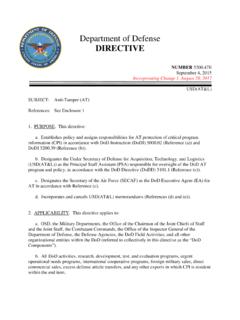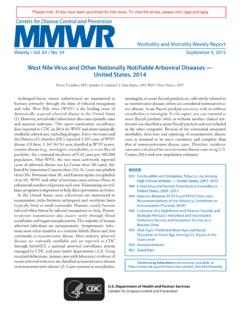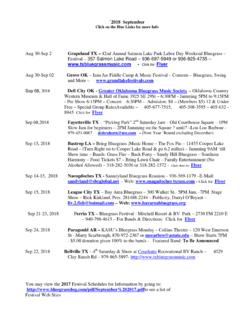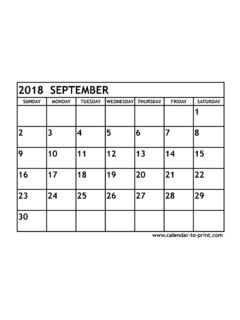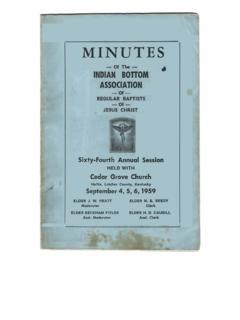Transcription of IASB amendments to IFRS 4 to address different …
1 IASB issues amendments to ifrs 4 to address the different effective dates of ifrs 9 and ifrs 17 Insurance Accounting AlertSeptember 2016 What you need to know The IASB issued amendments to ifrs 4 to address issues arising from the different effective dates of ifrs 9 and the upcoming new insurance contracts standard ifrs 17 (previously referred to as ifrs 4 Phase II). Entities issuing insurance contracts will still be able to adopt ifrs 9 on 1 January 2018. The amendments introduce two alternative options for entities issuing contracts within the scope of ifrs 4, notably a temporary exemption and an overlay approach. The temporary exemption enables eligible entities to defer the implementation date of ifrs 9. The overlay approach allows an entity applying ifrs 9 from 2018 onwards to remove from profit or loss the effects of some of the accounting mismatches that may occur from applying ifrs 9 before ifrs 17 is 12 september 2016, the International Accounting Standards Board (IASB or the Board) issued Applying ifrs 9 Financial Instruments with ifrs 4 Insurance Contracts ( amendments to ifrs 4) (the amendments ).
2 The amendments change the existing ifrs 4 Insurance contracts ( ifrs 4) to allow entities issuing insurance contracts within the scope of ifrs 4 to mitigate certain effects of applying ifrs 9 Financial Instruments before the IASB s new insurance contracts standard (referred to as ifrs 17 Insurance Contracts) becomes effective . The amendments help to resolve issues arising from the different effective dates for ifrs 9 (1 January 2018) and ifrs 17 (still to be decided, but not before 1 January 2020).2 Insurance Accounting Alert september 2016 |Reasons for issuing the amendments In July 2014, the IASB issued the completed version of its new standard on financial instruments, ifrs 9, with an effective date of 1 January 2018. During the re-deliberations on the Board s insurance contracts project, many constituents commented that the effective dates of ifrs 9 and ifrs 17 should be aligned. As a result of delays to the anticipated timetable of the insurance contracts project, the Board concluded that it would be impossible to issue ifrs 17 with an effective date aligned with ifrs 9 and decided instead to amend ifrs 4 to address constituents requests to permit insurers to defer the application of ifrs 9.
3 Constituents requested deferral of ifrs 9 because misaligned effective dates would give rise to the following:1. Additional accounting mismatches and temporary volatility in profit or loss if ifrs 9 were applied before ifrs 172. Reassessment of the classification and measurement of financial assets under ifrs 9 when adopting ifrs 17 to minimise accounting mismatches3. Two sets of major accounting change in a short space of time resulting in significant cost and effort for both users and preparers of financial statementsThe Board evaluated these concerns and concluded that the existing options in ifrs 41 and the transition requirements in the future insurance contracts standard2 were not sufficient to address the issues resulting amendments to ifrs 4 are intended to address accounting mismatches (and the resulting additional temporary volatility in profit or loss) arising from the different effective dates of ifrs 9 and ifrs 17.
4 These amendments also address the concerns over the additional cost and effort for preparers and users of financial statements as a result of applying two consecutive sets of major accounting changes in a short period of of the amendments Entities issuing insurance contracts will still be able to adopt ifrs 9 on 1 January 2018 without any further specific changes. In addition, the amendments introduce two alternative options that will allow entities issuing contracts within the scope of ifrs 4:1. To apply a temporary exemption from applying ifrs 9 until the earlier of the effective date of a new insurance contracts standard and annual reporting periods beginning on or after 1 January 2021. This exemption will only be available to entities whose activities are predominantly connected with insurance (temporary exemption) Or2. Adopt ifrs 9 but, for designated financial assets, remove from profit or loss the effects of some of the accounting mismatches that may occur before ifrs 17 is implemented (overlay approach)The amendments make these alternative options part of ifrs 4, rather than changing ifrs 9.
5 Temporary exemption The temporary exemption can only be applied by a reporting entity if its activities are predominantly connected with insurance, and it has not applied ifrs 9 As the exemption is meant to be temporary, it will not be available for reporting periods starting on or after 1 January 2021. Predominance assessment The assessment for whether a reporting entity s activities are predominantly connected with insurance is based on the liabilities connected with insurance in proportion to the entity s total liabilities. For this purpose, liabilities connected with insurance comprise:1. Liabilities arising from contracts within the scope of ifrs 4, which include any deposit components or embedded derivatives that are unbundled from insurance contracts in accordance with ifrs 42. Non-derivative investment contract liabilities measured at fair value through profit or loss applying IAS 39 Financial Instruments: Recognition and Measurement1 The existing ifrs 4 allows entities to change accounting policies voluntarily for insurance contracts if the change makes the financial statements more relevant to the economic decision-making needs of users, but no less reliable (or vice versa).
6 In addition, the existing ifrs 4 allows the selection of current market interest rates for the discounting of insurance liabilities and the adoption of shadow accounting. 2 As part of its insurance contracts project, the Board plans to include transition provisions in the new insurance contracts standard that allow insurers to revisit certain areas of the classification and measurement of financial assets under ifrs 9 when adopting the new insurance contracts ifrs 9 allows an entity to early apply the own credit requirements for non-derivative financial liabilities before the final version of ifrs 9 is applied. These provisions require an entity to present in OCI the fair value gains and losses attributable to changes in the entity s own credit risk for non-derivative financial liabilities designated as measured at FVPL. An entity may still choose to apply the temporary exemption if it early applied these own credit requirements or decide to early adopt these requirements in a later year and continue to apply the temporary exemption.
7 How we see itInsurers will welcome the possibility to defer implementation of ifrs 9 until ifrs 17 becomes effective (or, if earlier, 1 January 2021). Even though there will be reduced comparability between insurers and other entities that apply ifrs 9 for a number of years, the IASB s desire to address the consequences of having different effective dates for ifrs 17 and ifrs 9 is understandable. The solution will be optional so companies can still apply ifrs 9 without an adjustment starting 1 January 2018. Insurance groups will need to finalise their analyses to determine whether they are eligible for the temporary exemption and what the impact of ifrs 9 will be at group level. In addition, insurance groups will also need to evaluate whether the temporary exemption would be available for the individual financial statements of any subsidiaries within the effective date of ifrs 9 (1 January 2018) is approaching rapidly, therefore, insurance companies need to conclude which approach they will take towards applying ifrs 9 together with ifrs 17 as soon as Accounting Alert september 2016 |3.
8 Liabilities that arise because the insurer issues, or fulfils, obligations arising from the contracts in (1) and (2) above The amendments mention as examples of items that will qualify under point (3) above, the following: derivatives used to mitigate risks arising from those contracts referred to under points (1) and (2) and from the assets backing those contracts; relevant tax liabilities such as the deferred tax liabilities for temporary taxable differences on liabilities arising from those contracts; and debt issued that is included in the insurer s regulatory capital as liabilities that arise to fulfil contracts within the scope of ifrs entity may elect the temporary exemption if, and only if: The carrying amount of its liabilities arising from contracts included under (1) above, is significant compared to the total carrying amount of all its liabilities The percentage of the total carrying amount of its liabilities connected with insurance, included under (1) through (3) above, relative to the total carrying amount of all of its liabilities is1.
9 Greater than 90 per centOr2. Less than or equal to 90 per cent but greater than 80 per cent, and the insurer does not engage in a significant activity unconnected with insurance In assessing whether the entity does not engage in a significant activity unconnected with insurance, it should consider quantitative or qualitative factors (or both), including publicly available information such as the industry classification that users of financial statements apply to the insurer. When performing this assessment, the entity only takes into account those activities from which it may earn revenues and incur expenses. Diagram 1 illustrates the possible outcomes of the assessment of the eligibility for the temporary 1: Assessment of eligibility for temporary exemption Insurance liabilities, Investment contracts with DPF, IAS 39 liabilities as at FVPL Other liabilities connected with insurance activitiesLiabilities not connected with insurance activitiesPredominance percentageAdditional Assessment: Qualitative Quantitative90%80%The Board decided that an entity should calculate the percentage of the total carrying amount of its liabilities connected with insurance relative to the total carrying amount of all of its liabilities (the predominance percentage) using the carrying amounts of liabilities reported on its balance sheet at the annual reporting date after 31 March 2015 and before 1 April 2016 ( , the initial assessment date ).
10 This time frame is intended to reduce uncertainty about whether an entity needs to adopt ifrs 9 in 2018, and thereby provide time to plan for Accounting Alert september 2016 |Example 1: Calculation of the predominance percentageA reporting entity has the following gross liabilities at its financial statements for the period ending 31 December 2015:CUInsurance contract liabilities500 Investment contract liabilities at FVPL 200 Debt issued for regulatory capital purposes100 Derivatives used for hedges of insurance liabilities 60 Deferred tax liabilities on insurance contract liabilities50 Banking liabilities ( , customer deposits)90 Total liabilities1,000 Predominance percentage = 91% ( , (500+200+100+60+50)/1,000). Therefore, the reporting entity qualifies for the temporary exemption from ifrs of predominance An entity that elected to apply the temporary exemption will be required to reassess whether its activities are still predominantly connected with insurance if, and only if, there has been a change in the activities of the entity that results in starting or ending an activity that is significant to its operations or significantly changes the magnitude of one of its activities, for example, when the entity has acquired, disposed of or terminated a business line, the IASB expects changes in business that lead to a reassessment of predominance to be very reassessment, an entity should re-calculate the predominance percentage at the end of the annual reporting period in which the change in activities takes place.










